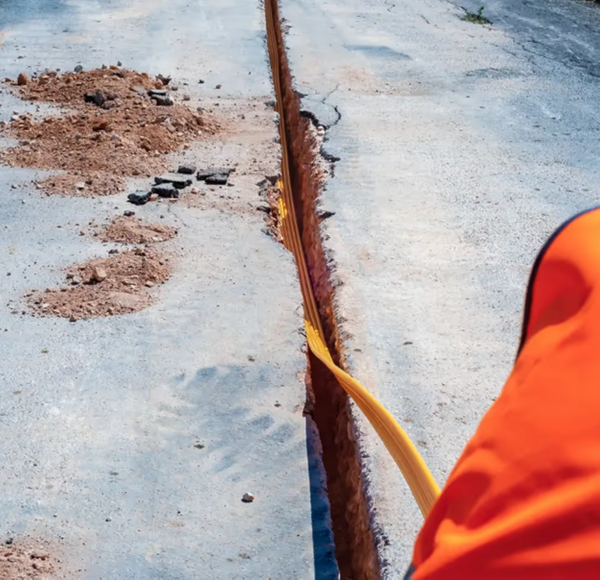Explaining Microtrenching: A Modern Approach to Installing Subsurface Utilities
Some utilities require deeper installation to meet safety or regulatory standards, but for others, microtrenching may be a valuable solution.

Unlike traditional trenching, microtrenching’s narrow cuts mean less damage to roads, sidewalks, and landscaping.
As infrastructure continues to evolve, the demand for efficient and less disruptive methods of installing subsurface utilities has grown significantly. Traditional excavation techniques, while effective, often result in major surface disruption, increased costs, and environmental concerns. Microtrenching has emerged as a modern solution that addresses many of these issues. It offers a faster, cleaner, and more cost-effective way to install utility lines such as fiber-optic cables, gas lines, and water pipes.
What is Microtrenching?
Microtrenching is a specialized construction technique used to install underground utilities with minimal impact on the surface. The process involves cutting a narrow trench, usually between 1 and 4 inches wide and up to 24 inches deep, along paved surfaces like sidewalks or roadways. After the trench is cut, utility lines are placed inside and the trench is filled with a fast-setting material that restores the surface to its original condition. Compared to traditional trenching, microtrenching is quicker, less invasive, and more efficient.
Benefits of Microtrenching
Reduced Surface Impact
One of the most notable advantages of microtrenching is the limited surface disruption it causes. Conventional trenching often requires wide, deep cuts that can damage roads, sidewalks, and landscaping. Microtrenching, by contrast, involves much narrower cuts, which means less damage and fewer repairs. This results in fewer inconveniences for local residents and businesses and helps reduce the cost and time associated with surface restoration.
Lower Project Costs
Microtrenching is generally more affordable than traditional excavation. Because the trenches are smaller, there is less material to remove and replace. This reduces labor and equipment expenses. Additionally, the faster pace of installation helps lower overall project costs. For municipalities and contractors working within tight budgets, microtrenching can be a more economical choice.
Faster Installation
Speed is another key benefit of microtrenching. The process allows for rapid deployment of utility lines, which is especially valuable in projects with strict deadlines. Whether expanding broadband access or upgrading existing infrastructure, microtrenching enables crews to complete work more quickly than traditional methods. This can be particularly useful in urban areas where minimizing disruption is a priority.
Environmentally Friendly
Microtrenching is often considered a more environmentally responsible option. The smaller trench size means less soil is disturbed, which helps protect tree roots and nearby ecosystems. The reduced need for heavy machinery also leads to lower fuel consumption and fewer emissions. For projects with sustainability goals, microtrenching offers a practical way to reduce environmental impact.
Challenges of Microtrenching
Limited Trench Depth
One of the main limitations of microtrenching is the shallow depth of the trench. Some utilities require deeper installation to meet safety or regulatory standards. In these cases, microtrenching may not be suitable, and traditional trenching methods may still be necessary. It is important to evaluate the specific requirements of each project before choosing this method.
Increased Risk of Surface Damage
Because microtrenches are cut close to the surface, the utility lines inside may be more vulnerable to damage from future construction or heavy traffic. This can lead to service interruptions and costly repairs. Proper planning and protective measures are essential to reduce the risk of damage over time.
Weather-Related Delays
Microtrenching is sensitive to weather conditions. Rain, snow, or freezing temperatures can interfere with the setting of the backfill material, potentially causing delays or structural issues. Scheduling work during favorable weather conditions is important to ensure the long-term success of the installation.
Difficulty in Congested Utility Areas
In areas with a high density of existing underground utilities, microtrenching can be more complex. The narrow trench leaves little room for error, and the risk of striking existing lines is higher. Accurate utility mapping and precise cutting techniques are necessary to avoid accidental damage and ensure safety.
A Balanced Approach
Microtrenching presents a compelling option for many utility installation projects. Its ability to reduce surface disruption, lower costs, and speed up deployment makes it especially useful in urban environments and time-sensitive situations. However, it is not a universal solution. The method’s limitations, including shallow depth and sensitivity to weather, mean that it is not appropriate for every project. A thorough assessment of site conditions and utility requirements is essential before deciding to use microtrenching.
How GPRS Helps Reduce Risk During Microtrenching
Any time excavation is involved, there is a risk of damaging existing underground infrastructure. The average cost of a utility strike is $56,000, not including the potential for up to eight weeks of project delays. These incidents can also pose serious safety risks and damage a company’s reputation.
GPRS provides utility locating services that help reduce the risk of subsurface damage during microtrenching. Our team delivers accurate, detailed maps of underground infrastructure, giving contractors the information they need to dig safely and efficiently.
While it is required by law to contact your state’s 811 one-call service before digging, it is important to understand the limitations of this service. 811 contractors only locate public utilities. They do not identify private utility lines, which make up approximately 60% of all underground infrastructure. This gap in coverage can leave projects vulnerable to costly and dangerous utility strikes.
Hiring a professional utility locating service like GPRS is a critical step in protecting your project. Our experienced technicians use advanced equipment to locate both public and private utilities, ensuring that your microtrenching work proceeds without unexpected setbacks. With GPRS, you can keep your project on schedule, within budget, and safe for everyone involved.
Want to see what GPRS can help you uncover? Click below to schedule a service or request a quote today.
